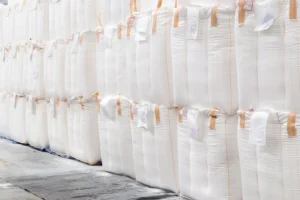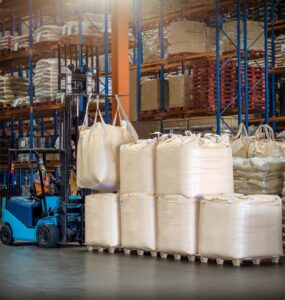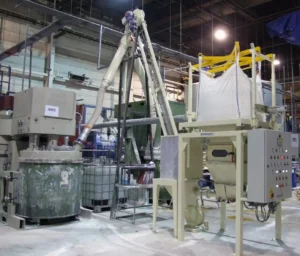Controlling dusting and product spillage, while safely unloading bulk bags, is an industry-wide challenge. Many times standard, off-the-shelf bulk bag unloaders are utilized in a new process without a thorough understanding of the nature of the product. This often results in the need for an often expensive retrofit assembly after installation and unnecessary commissioning delays. What should be considered to ensure dust-free bulk bag unloading?
Here are the key factors to keep in mind:
The Supplier
Specialist suppliers offering bulk bag unloaders for material handling can supply several types of equipment with dust containment options suitable for unloading a variety of materials. Look for a bulk material handling supplier that has experience with the materials you want to unload and has the technical expertise to apply their equipment to the specific requirements of your application. This normally requires an engineered solution, with layout drawings, that detail any necessary custom designed parts to adapt the recommended system to suit your application and location. Experienced suppliers are able to adapt their equipment for different situations to provide an effective solution.
Material Testing
Have the supplier test your product in the bulk bag unloader being considered to verify the suitability, and specifically dust control capabilities, of the equipment for your application.
Bulk Bag Design
Proper bulk bag selection is one of the most important considerations for dust containment in a bulk bag unloading system. The bulk bag must contain the fines present in your product or particles can sift through the bag fabric. Depending on the amount of fines present in the product, the particle size, and its shape, a coated fabric may be all that is required to contain the dust. If coated fabric doesn’t contain the product fines, polyethylene bulk bag liners can be used to prevent product sifting. Inlet spouted bags, not open top bags, should always be used for dusty materials.
Integral Dust Collection
Bulk bag unloaders can be configured with an integral dust collection system. This is an important option for discharging dusty materials. Bulk bag unloaders can also be designed with a port to tie into a plant-wide dust collection system.
Dust Tight Bag Seating
Pay attention to how a full bulk bag is installed within the frame of the bulk bag unloader, as this can be a source of unwanted material dusting. Often a dust-tight docking seal built within the base of the bulk bag unloader can significantly help mitigate dusting.
Bulk Bag Tensioning
Make sure your bulk bag unloaders are designed to properly tension the bulk bag, and any associated liner so that the complete contents of each bag is discharged. Residual material trapped in bag creases and folds can potentially increase dusting and spillage during bag removal.
Enclosed Access Chamber
Nearly half of all spillage and dusting occurs during the bag spout untying process. Controlling dust becomes a much bigger challenge in cases where the product is free-flowing. Look for a bulk bag unloader design where the bag spout access chamber is enclosed and kept under a slight negative pressure to minimize dusting issues and contain spillage. For hazardous material applications a glove box arrangement, instead of access chamber doors, should be considered to prevent operator exposure.
Sanitary Spout Docking
Positive spout docking arrangements can ensure complete product containment and also allow for efficient bag stretching at the end of the discharge cycle. Consider this design option with or without the access chamber. Efficiently docking a spout can require some dexterity and performing this operation in an enclosed area can compensate for operator errors.
‘Empty’ Bulk Bag Removal
Dusting can often occur during the ’empty’ bag removal cycle. It is imperative to tie off the bag spout tightly prior to bag removal. Consider adding a ‘bag collapsing’ feature that utilizes a dust collector to evacuate the bag and rid the environment of suspended dust. Again, an enclosed access chamber facilitates the capture of any fugitive dust during this step in your operation.
Downstream Process Optimization
Allowingsufficient time for the operator to perform each of the necessary steps in the bulk bag unloading process is essential. Planning for strategic time buffers throughout the process can eliminate downtime and allow the operator to properly perform all the necessary operations for a dust-free bulk bag unloading operation!




